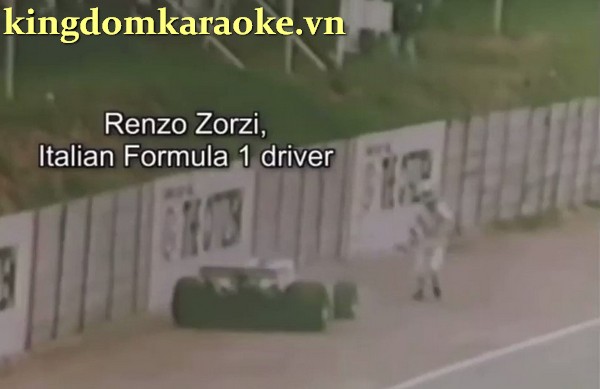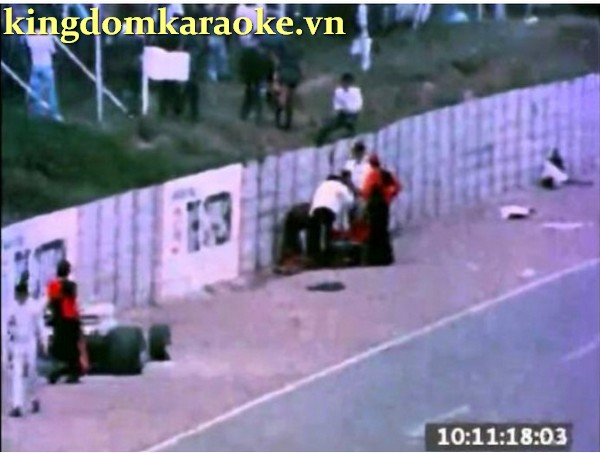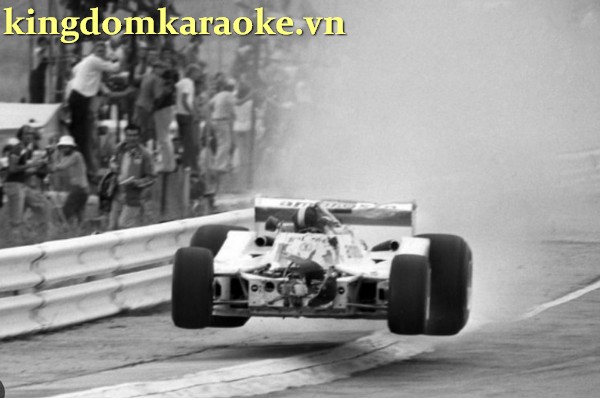Watch Full: 1977 African Grand Prix Crash Video Original

The “1977 African Grand Prix Crash Video” encapsulates a pivotal moment in motorsport history. This gripping footage offers a visceral look into the dramatic crash that occurred during the 1977 African Grand Prix, providing an authentic glimpse into this infamous incident. Viewers are transported back in time to experience the intensity and impact of this viral video in its entirety on kingdomkaraoke.vn. It serves as a significant historical document, inviting racing enthusiasts to witness the heart-stopping events of that day. This video has become a symbol of Formula One’s commitment to safety and its enduring legacy, reminding us of the sport’s evolution over the years.
I. The Viral Phenomenon of the 1977 African Grand Prix Crash Video
The 1977 African Grand Prix Crash Video achieved remarkable status as a viral sensation, captivating audiences around the world and leaving a lasting impact on motorsport enthusiasts. This section delves into the factors that contributed to its viral success, examining how it resonated with viewers and its extensive circulation on social media and video sharing platforms.
1. The Shocking Nature of the Footage
At the heart of its virality lies the sheer shock value of the video. The footage captured a moment of intense drama and tragedy during the 1977 African Grand Prix, which drew viewers in with its raw, unfiltered depiction of a high-speed racing incident. This shock factor played a pivotal role in grabbing the attention of viewers and sparking conversations across the internet.
2. Social Media Sharing
The video’s viral journey was propelled by social media platforms. Users shared and reshared the video on platforms like Facebook, Twitter, and Instagram, exponentially increasing its reach. The immediacy and ease of sharing on social media made it effortless for viewers to pass along the footage to their networks, contributing to its rapid dissemination.
3. Engagement within Online Communities
Online communities of motorsport enthusiasts played a significant role in the video’s virality. Discussion forums, Reddit threads, and niche racing fan groups eagerly embraced the footage, sparking debates, analyses, and sharing among their members. This communal engagement further fueled the video’s viral spread.
4. Public Fascination with Dramatic Footage
Human curiosity and the enduring allure of gripping, dramatic content also played their part. The 1977 African Grand Prix Crash Video tapped into society’s fascination with historical events and shocking, impactful footage. Viewers were drawn to the video not only for its historical significance but also for the intense emotions it evoked.

5. International Reach and Cross-Cultural Appeal
The video transcended geographic and cultural boundaries. Racing fans and curious onlookers from diverse backgrounds were united by their shared interest in witnessing a pivotal moment in Formula One history. The video’s global appeal contributed to its widespread circulation.
II. Safety Measures and Their Role in the 1977 African Grand Prix Crash Video
The “1977 African Grand Prix Crash Video” not only serves as a poignant historical document but also as a stark reminder of the safety challenges faced in Formula One during that era. In this section, we will delve into the safety measures that were in place during the 1977 African Grand Prix and how they played a critical role in shaping the severity of the crash captured on video.
1. Limited Run-off Areas and Inadequate Barriers
One of the most significant factors contributing to the severity of the “1977 African Grand Prix Crash Video” was the insufficient run-off areas and barriers on the Kyalami Circuit. The circuit featured limited space for drivers to recover from high-speed incidents, making it challenging for them to regain control of their cars. Insufficient barriers meant that collisions with trackside objects or other vehicles had a higher likelihood of causing severe damage. This lack of protective infrastructure exacerbated the risk and impact of accidents.
2. Presence of Track Personnel During Races
The incident captured in the “1977 African Grand Prix Crash Video” highlighted another critical safety issue: the presence of track personnel, including race marshals, on the circuit during an active race. In the heat of the moment, race marshals rushed across the track to extinguish a fire on Renzo Zorzi’s stranded car, inadvertently putting themselves in harm’s way. The absence of clear protocols for handling such situations further escalated the danger.
3. The Role of Safety Equipment
During the 1977 African Grand Prix, safety equipment for drivers was less advanced compared to modern standards. Seatbelts and harnesses, for instance, were not as effective in withstanding high-speed impacts. Fire-resistant materials for driver suits were not mandatory, exposing drivers to greater risks during fire-related incidents. The inadequacy of safety equipment increased the vulnerability of drivers during accidents.
4. Lack of Advanced Communication Systems
Communication between race control and marshals was less advanced in 1977, hindering the coordination of safety responses during emergencies. Ineffective communication systems could lead to delays in addressing on-track incidents, potentially exacerbating their severity. Improved communication technology, which is now standard in Formula One, has since transformed safety response times.

5. The Evolution of Safety Standards
The safety standards of Formula One and motorsport, in general, have evolved significantly since 1977, profoundly impacting the sport’s safety landscape. The tragic events of that year served as a catalyst for change, prompting the sport to prioritize safety above all else. Stricter regulations, advanced safety equipment, larger run-off areas, improved barriers, and comprehensive safety protocols have since been implemented to protect drivers, track personnel, and spectators.
III. Immediate Consequences for Participants in the 1977 African Grand Prix Crash Video
The 1977 African Grand Prix Crash Video not only left an indelible mark on the history of Formula One but also brought immediate and tragic consequences for those directly involved in the incident. In this section, we will examine the immediate consequences, focusing on the heart-wrenching loss of life that occurred during the incident captured in the video.
1. Frederik Jansen van Vuuren’s Tragic Death
One of the most profound immediate consequences of the crash was the tragic loss of life. Frederik Jansen van Vuuren, a race marshal, lost his life when he was struck by Tom Pryce’s car during the collision. Van Vuuren’s untimely death was a somber reminder of the inherent dangers faced by those who work on the frontlines of motorsport events. His passing had a profound impact on his family, friends, and colleagues, leaving them to mourn the loss of a loved one who had been passionately involved in motorsport as a marshal.

2. Impact on Other Participants and Spectators
The incident captured in the video had a ripple effect on other participants in the race, as well as on the spectators who witnessed the tragedy. Drivers and race officials were emotionally affected by the harrowing events that unfolded on the track. Spectators in the grandstands and those watching at home were also deeply moved by the distressing scenes, serving as a stark reminder of the potential risks inherent in motorsport.
3. Spotlight on Safety Protocols and Training
The immediate consequences of the 1977 African Grand Prix crash video brought safety protocols and training for race marshals and track personnel into sharp focus. The incident highlighted the need for clearer guidelines and procedures for handling on-track emergencies and underscored the importance of ensuring the safety of those responsible for maintaining order during races.
IV. Formula One and Racing Governing Bodies’ Response to the 1977 African Grand Prix Crash Video
The release of the “1977 African Grand Prix Crash Video” had a profound impact on the motorsport community and prompted Formula One and racing governing bodies to take decisive actions in response to the crash. This section will describe the steps taken and the specific changes implemented to enhance safety in the aftermath of this tragic event.

1. Comprehensive Safety Reviews
Immediately following the incident, Formula One and racing governing bodies initiated comprehensive safety reviews. These reviews aimed to assess the shortcomings in safety measures and identify areas where improvements were urgently needed. The objective was to prevent similar accidents in the future.
2. Stricter Car Design Regulations
One of the first areas addressed was car design. Stricter regulations were introduced to enhance driver safety. This included improvements in driver restraints, such as harnesses and seatbelts, designed to better withstand high-speed impacts. Car designs were also modified to reinforce cockpits and improve crash structures, reducing the risk of injury during collisions.
3. Fire-Resistant Materials and Safety Gear
Safety gear requirements were reevaluated and strengthened. Fire-resistant materials became mandatory for driver suits, reducing the risk of injuries from fires or fuel-related incidents. Helmets were redesigned to withstand severe impacts while minimizing rotational forces that could cause brain injuries.
4. Enhanced Safety Protocols and Communication
Safety protocols and communication systems received significant upgrades. Clearer guidelines for handling incidents on the track were established, ensuring a more coordinated response during emergencies. Enhanced communication systems were implemented to relay important information more effectively among race control, marshals, and medical personnel.
5. Track Safety Improvements
Trackside safety also came under scrutiny. Advances in technology led to the development of energy-absorbing barriers such as SAFER (Steel And Foam Energy Reduction) barriers and TecPro barriers. These innovations were designed to decrease impact forces on drivers during collisions with trackside objects and overall crash severity.
6. Ongoing Commitment to Safety
The tragic events of the 1977 African Grand Prix crash video fundamentally changed the approach to safety in Formula One. Racing governing bodies and Formula One continued their commitment to improving safety standards, establishing a precedent for ongoing advancements in protective measures and regulations within the sport.
V. The Evolution of Safety Standards Since the 1977 African Grand Prix Crash Video
Since the release of the “1977 African Grand Prix Crash Video,” safety standards within Formula One have undergone a remarkable transformation, leading to significant improvements in driver survivability and overall safety on the track. This section will delve into the evolution of safety standards over the years, highlighting their profound impact on the sport.

1. Car Design and Chassis Safety
Car design and chassis safety have been at the forefront of safety advancements in Formula One. In the wake of the 1977 crash, regulations were revised to enforce the use of reinforced cockpits and improved crash structures. These changes aimed to protect drivers from severe injuries during high-speed collisions. Additionally, advancements in materials and engineering have led to the development of safer, more crash-resistant cars.
2. Driver Safety Gear
The safety gear worn by Formula One drivers has also seen substantial enhancements. Helmets, in particular, have evolved to provide better protection against severe impacts, including measures to reduce rotational forces that can cause brain injuries. The introduction of head-and-neck support systems like the HANS (Head And Neck Support) device has significantly reduced the risk of neck injuries during accidents.
3. Comprehensive Safety Regulations
Formula One has adopted comprehensive safety regulations covering a wide range of aspects, from car design to race procedures. These regulations address every facet of the sport, aiming to minimize risks and enhance safety. They include guidelines for driver restraints, fuel cell design, impact testing, and crash helmet standards, among others.
4. Improved Circuit Design
Circuit design has evolved to prioritize safety. Modern Formula One circuits feature larger run-off areas and advanced energy-absorbing barriers like SAFER (Steel And Foam Energy Reduction) barriers and TecPro barriers. These innovations are designed to reduce both the impact forces on drivers during collisions with trackside objects and overall crash severity.
5. Enhanced Medical Response
The medical response infrastructure within Formula One has also been elevated. Races now have dedicated medical teams with specialized equipment, ensuring rapid response and on-site medical care in the event of an accident. These advancements have been instrumental in minimizing injury severity.
6. Ongoing Research and Development
The commitment to safety within Formula One extends to ongoing research and development. Continuous innovation in materials, technology, and safety protocols is a hallmark of the sport. Data analysis and simulation technologies help identify potential risks and improve safety measures proactively.
VI. Conclusion
The “1977 African Grand Prix Crash Video” stands as an enduring testament to the evolution of safety within Formula One. This pivotal moment in motorsport history, marked by tragedy and captured in gripping detail, served as a catalyst for change. The sport’s response to the incident, and the subsequent transformation of safety standards, has reshaped Formula One into a safer and more secure arena for drivers, track personnel, and spectators alike.
From limited run-off areas and inadequate barriers to the introduction of energy-absorbing barriers and reinforced cockpits, Formula One has come a long way in enhancing safety infrastructure. The evolution of safety gear, such as helmets and head-and-neck support systems, has significantly reduced the risk of injuries during high-speed collisions.
Comprehensive regulations and guidelines now govern various aspects of the sport, covering car design, safety equipment, and race procedures. Improved circuit design, with larger run-off areas and advanced barriers, provides drivers with better chances of avoiding severe crashes.
The commitment to safety within Formula One remains unwavering, as ongoing research and development continue to drive progress in motorsport safety. Data analysis, simulation technologies, and the pursuit of innovative materials ensure that the sport remains at the forefront of safety advancements.
In the wake of the “1977 African Grand Prix Crash Video,” Formula One and racing governing bodies demonstrated their dedication to learning from the past and safeguarding the future. While the tragic events of that year are indelibly etched in the sport’s history, they have paved the way for a safer and more secure motorsport landscape. The sport’s enduring legacy is a tribute to the resilience of the human spirit and the commitment to protecting lives in the pursuit of speed and glory.







